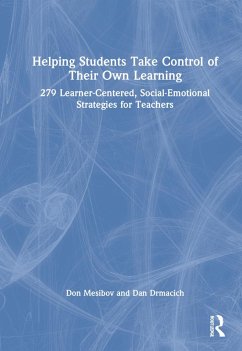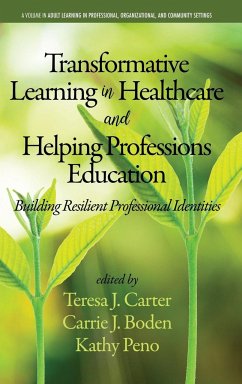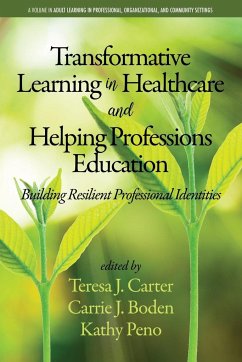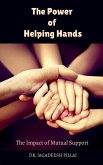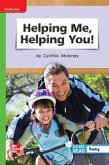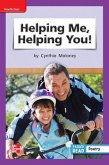Don Mesibov, Dan Drmacich
Helping Students Take Control of Their Own Learning
279 Learner-Centered, Social-Emotional Strategies for Teachers
Don Mesibov, Dan Drmacich
Helping Students Take Control of Their Own Learning
279 Learner-Centered, Social-Emotional Strategies for Teachers
- Gebundenes Buch
- Merkliste
- Auf die Merkliste
- Bewerten Bewerten
- Teilen
- Produkt teilen
- Produkterinnerung
- Produkterinnerung
What does learner-centered education look like, and how can we best put it into practice? This helpful book by experienced educators Don Mesibov and Dan Drmacich answers those questions and provides a wide variety of strategies, activities, and examples to help you with implementation. Chapters address topics such as positioning students at the center of the lesson and teachers as coaches, making tasks relevant and engaging, incorporating the affective domain and social-emotional learning, assessing learning, and more. Appropriate for new and experienced teachers of all grades and subjects,…mehr
Andere Kunden interessierten sich auch für
![Beyond Self-Care for Helping Professionals Beyond Self-Care for Helping Professionals]() Lisa D. HinzBeyond Self-Care for Helping Professionals58,99 €
Lisa D. HinzBeyond Self-Care for Helping Professionals58,99 €![Transformative Learning in Healthcare and Helping Professions Education Transformative Learning in Healthcare and Helping Professions Education]() Transformative Learning in Healthcare and Helping Professions Education108,99 €
Transformative Learning in Healthcare and Helping Professions Education108,99 €![Transformative Learning in Healthcare and Helping Professions Education Transformative Learning in Healthcare and Helping Professions Education]() Transformative Learning in Healthcare and Helping Professions Education63,99 €
Transformative Learning in Healthcare and Helping Professions Education63,99 €![The Power of Helping Hands The Power of Helping Hands]() JagadeeshThe Power of Helping Hands14,99 €
JagadeeshThe Power of Helping Hands14,99 €![Take Me to France: A French Book for the American Soldier Take Me to France: A French Book for the American Soldier]() Claude MichelonTake Me to France: A French Book for the American Soldier20,99 €
Claude MichelonTake Me to France: A French Book for the American Soldier20,99 €![Reading Wonders Leveled Reader Helping Me, Helping You!: Beyond Unit 6 Week 2 Grade 1 Reading Wonders Leveled Reader Helping Me, Helping You!: Beyond Unit 6 Week 2 Grade 1]() Reading Wonders Leveled Reader Helping Me, Helping You!: Beyond Unit 6 Week 2 Grade 119,99 €
Reading Wonders Leveled Reader Helping Me, Helping You!: Beyond Unit 6 Week 2 Grade 119,99 €![Reading Wonders Leveled Reader Helping Me, Helping You!: Ell Unit 6 Week 2 Grade 1 Reading Wonders Leveled Reader Helping Me, Helping You!: Ell Unit 6 Week 2 Grade 1]() Reading Wonders Leveled Reader Helping Me, Helping You!: Ell Unit 6 Week 2 Grade 119,99 €
Reading Wonders Leveled Reader Helping Me, Helping You!: Ell Unit 6 Week 2 Grade 119,99 €-
-
-
What does learner-centered education look like, and how can we best put it into practice? This helpful book by experienced educators Don Mesibov and Dan Drmacich answers those questions and provides a wide variety of strategies, activities, and examples to help you with implementation. Chapters address topics such as positioning students at the center of the lesson and teachers as coaches, making tasks relevant and engaging, incorporating the affective domain and social-emotional learning, assessing learning, and more. Appropriate for new and experienced teachers of all grades and subjects, this book will leave you feeling ready to help students take control of their own learning so they can reach higher levels of success.
Hinweis: Dieser Artikel kann nur an eine deutsche Lieferadresse ausgeliefert werden.
Hinweis: Dieser Artikel kann nur an eine deutsche Lieferadresse ausgeliefert werden.
Produktdetails
- Produktdetails
- Verlag: Routledge
- Seitenzahl: 274
- Erscheinungstermin: 16. Juni 2022
- Englisch
- Abmessung: 260mm x 183mm x 19mm
- Gewicht: 718g
- ISBN-13: 9781032257211
- ISBN-10: 1032257210
- Artikelnr.: 63116522
- Verlag: Routledge
- Seitenzahl: 274
- Erscheinungstermin: 16. Juni 2022
- Englisch
- Abmessung: 260mm x 183mm x 19mm
- Gewicht: 718g
- ISBN-13: 9781032257211
- ISBN-10: 1032257210
- Artikelnr.: 63116522
Don Mesibov has worked at a school for emotionally disturbed children, been a middle school English teacher, taught courses on constructivism at local colleges for 22 years, and worked for a teacher's union. Additionally, he is director of the Institute for Learning Centered Education, an organization he founded in 1995. Dan Drmacich was principal of the nationally renowned School Without Walls in Rochester, New York, a public school, and a member of the New York State Performance Standards Consortium, which requires performance-based assessments and a yearlong project to demonstrate competency for graduation rather than standardized tests. Dan is currently cofounder and coordinator of the Rochester Coalition for Public Education, an organization focused on research-based, progressive school reform and social justice.
Section One Why Do Schools Need To Change? Chapter 1 Learner-Centered
Education (LCE) And Social-Emotional Learning (SEL): You Can't Have One
Without The Other Chapter 2 The Iron Is Hot Chapter 3 Research Supports The
Need For Change Chapter 4 Best Practices Are For All Students Chapter 5
Many Students Are Bored And Unmotivated Section Two How Do The Teachers'
And Students' Roles Change? Chapter 6 It All Starts With The Teacher
Chapter 7 Prioritize What Impacts Student Learning Chapter 8 Student Needs,
Interests, And Learning Styles Should Be At The Center Of A Lesson Chapter
9 Motivation Is Derived From What Students Find Interesting, Relevant, Or
Just Plain Fun Chapter 10 Teachers Are Classroom Coaches Chapter 11
Critical Thinking Is The Main Focus For Student Learning Chapter 12
Advisories, Journaling And Conferencing Are Essential Chapter 13 Music And
Art Facilitate Learning In All Disciplines Chapter 14 Students Need A
Vision Chapter 15 Introverted (Or Quiet) Children Require Special
Strategies Chapter 16 Educators Can Make Use Of Lectures And Be Effective
Section Three Is There Room For The Affective Domain? Chapter 17 Content
And Social-Emotional Learning Are Compatible Chapter 18 Let All Students
Know They Are Liked As Individuals: The Classroom Culture Sends A Message
To Students Chapter 19 Teaching Good Citizenship Prepares Students For Life
And Raises Student Achievement Chapter 20 More Activities To Start The Year
Or To Use Any Time Section Four Do Students Find School Relevant? Chapter
21 Classroom Tasks Must Be Meaningful And Authentic Chapter 22 9/11 And
Covid-19: Opportunities For Student Learning Section Five How Do We Test
What Students Should Be Learning? Chapter 23 Assessment Practices Drive
Instruction Chapter 24 Standardized Tests Directly Impact What Teachers
Teach, What Students Learn, And How Students Learn Section Six What Should
All Teachers Understand? Chapter 25 How To Interact With Disruptive
Students Chapter 26 Schools Must Be Trauma-Sensitive Chapter 27 Social
Justice Is A Critical Element Of Good Citizenship Chapter 28 Addressing
Controversial Issues With Civil Discourse Through Effective Use Of
Student-Centered Practices Chapter 29 Lessons From Covid-19: Online
Instruction And Utilizing Technology Can Support, Not Replace, Good
Teaching Chapter 30 Change How Student Progress Is Reported Section Seven
Is Meaningful School Reform Possible? Chapter 31 Agents Of Change, Please
Step Forward Chapter 32 There Can Be Major School Reform At Minimal Cost
Epilogue Opportunities For Students Are Inequitable Appendix A Resources
For Advocacies And Journaling Appendix B Resources For Teaching Good
Citizenship Appendix C Resources For Teaching Social Justice
Education (LCE) And Social-Emotional Learning (SEL): You Can't Have One
Without The Other Chapter 2 The Iron Is Hot Chapter 3 Research Supports The
Need For Change Chapter 4 Best Practices Are For All Students Chapter 5
Many Students Are Bored And Unmotivated Section Two How Do The Teachers'
And Students' Roles Change? Chapter 6 It All Starts With The Teacher
Chapter 7 Prioritize What Impacts Student Learning Chapter 8 Student Needs,
Interests, And Learning Styles Should Be At The Center Of A Lesson Chapter
9 Motivation Is Derived From What Students Find Interesting, Relevant, Or
Just Plain Fun Chapter 10 Teachers Are Classroom Coaches Chapter 11
Critical Thinking Is The Main Focus For Student Learning Chapter 12
Advisories, Journaling And Conferencing Are Essential Chapter 13 Music And
Art Facilitate Learning In All Disciplines Chapter 14 Students Need A
Vision Chapter 15 Introverted (Or Quiet) Children Require Special
Strategies Chapter 16 Educators Can Make Use Of Lectures And Be Effective
Section Three Is There Room For The Affective Domain? Chapter 17 Content
And Social-Emotional Learning Are Compatible Chapter 18 Let All Students
Know They Are Liked As Individuals: The Classroom Culture Sends A Message
To Students Chapter 19 Teaching Good Citizenship Prepares Students For Life
And Raises Student Achievement Chapter 20 More Activities To Start The Year
Or To Use Any Time Section Four Do Students Find School Relevant? Chapter
21 Classroom Tasks Must Be Meaningful And Authentic Chapter 22 9/11 And
Covid-19: Opportunities For Student Learning Section Five How Do We Test
What Students Should Be Learning? Chapter 23 Assessment Practices Drive
Instruction Chapter 24 Standardized Tests Directly Impact What Teachers
Teach, What Students Learn, And How Students Learn Section Six What Should
All Teachers Understand? Chapter 25 How To Interact With Disruptive
Students Chapter 26 Schools Must Be Trauma-Sensitive Chapter 27 Social
Justice Is A Critical Element Of Good Citizenship Chapter 28 Addressing
Controversial Issues With Civil Discourse Through Effective Use Of
Student-Centered Practices Chapter 29 Lessons From Covid-19: Online
Instruction And Utilizing Technology Can Support, Not Replace, Good
Teaching Chapter 30 Change How Student Progress Is Reported Section Seven
Is Meaningful School Reform Possible? Chapter 31 Agents Of Change, Please
Step Forward Chapter 32 There Can Be Major School Reform At Minimal Cost
Epilogue Opportunities For Students Are Inequitable Appendix A Resources
For Advocacies And Journaling Appendix B Resources For Teaching Good
Citizenship Appendix C Resources For Teaching Social Justice
Section One Why Do Schools Need To Change? Chapter 1 Learner-Centered
Education (LCE) And Social-Emotional Learning (SEL): You Can't Have One
Without The Other Chapter 2 The Iron Is Hot Chapter 3 Research Supports The
Need For Change Chapter 4 Best Practices Are For All Students Chapter 5
Many Students Are Bored And Unmotivated Section Two How Do The Teachers'
And Students' Roles Change? Chapter 6 It All Starts With The Teacher
Chapter 7 Prioritize What Impacts Student Learning Chapter 8 Student Needs,
Interests, And Learning Styles Should Be At The Center Of A Lesson Chapter
9 Motivation Is Derived From What Students Find Interesting, Relevant, Or
Just Plain Fun Chapter 10 Teachers Are Classroom Coaches Chapter 11
Critical Thinking Is The Main Focus For Student Learning Chapter 12
Advisories, Journaling And Conferencing Are Essential Chapter 13 Music And
Art Facilitate Learning In All Disciplines Chapter 14 Students Need A
Vision Chapter 15 Introverted (Or Quiet) Children Require Special
Strategies Chapter 16 Educators Can Make Use Of Lectures And Be Effective
Section Three Is There Room For The Affective Domain? Chapter 17 Content
And Social-Emotional Learning Are Compatible Chapter 18 Let All Students
Know They Are Liked As Individuals: The Classroom Culture Sends A Message
To Students Chapter 19 Teaching Good Citizenship Prepares Students For Life
And Raises Student Achievement Chapter 20 More Activities To Start The Year
Or To Use Any Time Section Four Do Students Find School Relevant? Chapter
21 Classroom Tasks Must Be Meaningful And Authentic Chapter 22 9/11 And
Covid-19: Opportunities For Student Learning Section Five How Do We Test
What Students Should Be Learning? Chapter 23 Assessment Practices Drive
Instruction Chapter 24 Standardized Tests Directly Impact What Teachers
Teach, What Students Learn, And How Students Learn Section Six What Should
All Teachers Understand? Chapter 25 How To Interact With Disruptive
Students Chapter 26 Schools Must Be Trauma-Sensitive Chapter 27 Social
Justice Is A Critical Element Of Good Citizenship Chapter 28 Addressing
Controversial Issues With Civil Discourse Through Effective Use Of
Student-Centered Practices Chapter 29 Lessons From Covid-19: Online
Instruction And Utilizing Technology Can Support, Not Replace, Good
Teaching Chapter 30 Change How Student Progress Is Reported Section Seven
Is Meaningful School Reform Possible? Chapter 31 Agents Of Change, Please
Step Forward Chapter 32 There Can Be Major School Reform At Minimal Cost
Epilogue Opportunities For Students Are Inequitable Appendix A Resources
For Advocacies And Journaling Appendix B Resources For Teaching Good
Citizenship Appendix C Resources For Teaching Social Justice
Education (LCE) And Social-Emotional Learning (SEL): You Can't Have One
Without The Other Chapter 2 The Iron Is Hot Chapter 3 Research Supports The
Need For Change Chapter 4 Best Practices Are For All Students Chapter 5
Many Students Are Bored And Unmotivated Section Two How Do The Teachers'
And Students' Roles Change? Chapter 6 It All Starts With The Teacher
Chapter 7 Prioritize What Impacts Student Learning Chapter 8 Student Needs,
Interests, And Learning Styles Should Be At The Center Of A Lesson Chapter
9 Motivation Is Derived From What Students Find Interesting, Relevant, Or
Just Plain Fun Chapter 10 Teachers Are Classroom Coaches Chapter 11
Critical Thinking Is The Main Focus For Student Learning Chapter 12
Advisories, Journaling And Conferencing Are Essential Chapter 13 Music And
Art Facilitate Learning In All Disciplines Chapter 14 Students Need A
Vision Chapter 15 Introverted (Or Quiet) Children Require Special
Strategies Chapter 16 Educators Can Make Use Of Lectures And Be Effective
Section Three Is There Room For The Affective Domain? Chapter 17 Content
And Social-Emotional Learning Are Compatible Chapter 18 Let All Students
Know They Are Liked As Individuals: The Classroom Culture Sends A Message
To Students Chapter 19 Teaching Good Citizenship Prepares Students For Life
And Raises Student Achievement Chapter 20 More Activities To Start The Year
Or To Use Any Time Section Four Do Students Find School Relevant? Chapter
21 Classroom Tasks Must Be Meaningful And Authentic Chapter 22 9/11 And
Covid-19: Opportunities For Student Learning Section Five How Do We Test
What Students Should Be Learning? Chapter 23 Assessment Practices Drive
Instruction Chapter 24 Standardized Tests Directly Impact What Teachers
Teach, What Students Learn, And How Students Learn Section Six What Should
All Teachers Understand? Chapter 25 How To Interact With Disruptive
Students Chapter 26 Schools Must Be Trauma-Sensitive Chapter 27 Social
Justice Is A Critical Element Of Good Citizenship Chapter 28 Addressing
Controversial Issues With Civil Discourse Through Effective Use Of
Student-Centered Practices Chapter 29 Lessons From Covid-19: Online
Instruction And Utilizing Technology Can Support, Not Replace, Good
Teaching Chapter 30 Change How Student Progress Is Reported Section Seven
Is Meaningful School Reform Possible? Chapter 31 Agents Of Change, Please
Step Forward Chapter 32 There Can Be Major School Reform At Minimal Cost
Epilogue Opportunities For Students Are Inequitable Appendix A Resources
For Advocacies And Journaling Appendix B Resources For Teaching Good
Citizenship Appendix C Resources For Teaching Social Justice
